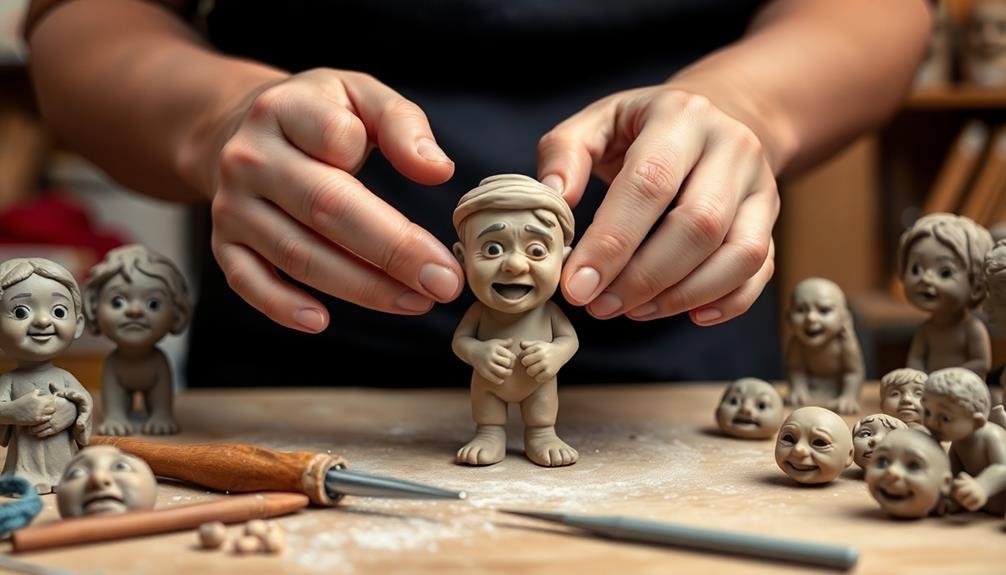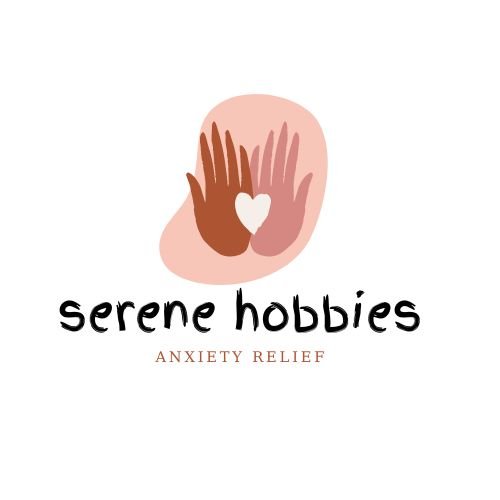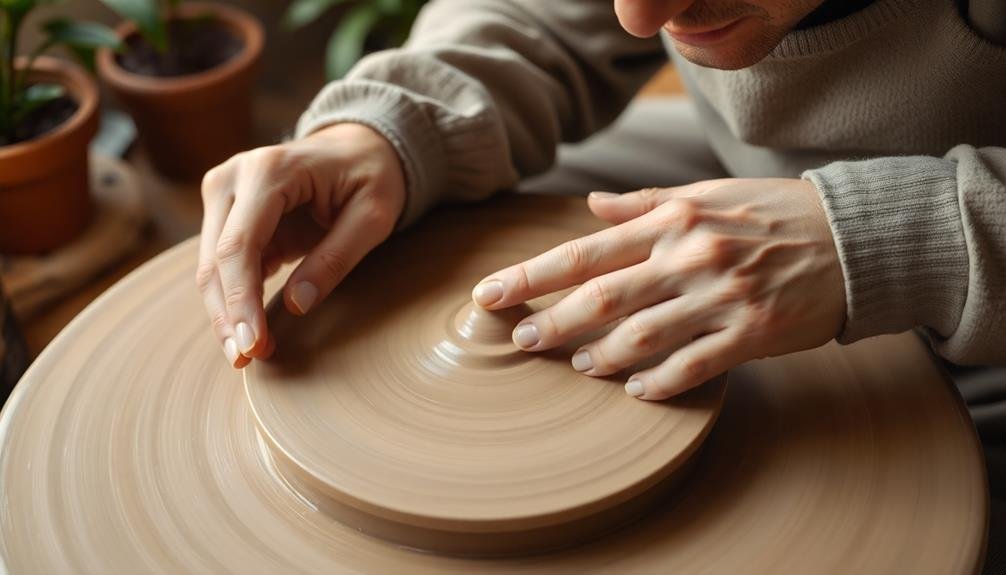Clay sculpting offers five soothing methods to ease anxiety. You can try Pinch Pot Meditation, centering yourself while shaping a bowl. Coil Building promotes calm through repetitive motions. Slab Construction encourages patience and focus as you create structured forms. Mindful Texture Exploration lets you engage your senses fully, quieting racing thoughts. Finally, Figurative Sculpting allows for emotional expression through symbolic representations. Each technique engages your hands and mind, grounding you in the present moment. These tactile practices provide a meditative escape from stress, helping you find inner peace. Discover which method resonates most with your journey to tranquility.
Pinch Pot Meditation

Starting with a simple technique, pinch pot meditation offers a soothing introduction to clay sculpting for anxiety relief.
Begin by centering yourself in a quiet space, taking deep breaths to calm your mind. Hold a ball of clay in your hands, feeling its cool texture and weight.
As you focus on your breathing, use your thumb to press into the center of the clay ball. Slowly pinch and rotate the clay, gradually forming a small bowl shape. Pay attention to the sensations in your fingers and palms as you work.
Continue pinching and smoothing the clay, allowing your thoughts to drift away. If your mind wanders, gently bring your focus back to the clay and your breath. Don't worry about perfection; the process is more important than the result.
As you shape the pot, visualize your anxieties being transferred into the clay. With each pinch, imagine releasing tension and worry.
When you're satisfied with the form, set the pot aside. Take a moment to reflect on the calming experience and the physical representation of your emotional release.
Coil Building for Calm
Building on the meditative qualities of pinch pots, coil building offers another calming technique for anxiety relief. This method involves rolling out long, snake-like coils of clay and stacking them to create various shapes and structures. As you focus on crafting each coil, you'll find your mind settling into a peaceful rhythm.
Start by rolling a small ball of clay between your palms, then use your fingertips to elongate it into a thin rope. Place the first coil in a circular shape on your work surface, then add subsequent coils on top, gently pressing them together. You can create simple bowls or more complex forms as your skills improve.
The repetitive nature of coil building helps quiet anxious thoughts. Pay attention to the texture of the clay, the pressure of your fingers, and the gradual growth of your creation. This mindful process encourages deep breathing and concentration, effectively reducing stress.
As you build your piece, layer by layer, you're also constructing a sense of accomplishment and control, which can be empowering when anxiety feels overwhelming.
Slab Construction Stress Relief

Slab construction offers a third avenue for stress relief through clay sculpting. This technique involves rolling out clay into flat sheets, which you then cut, shape, and assemble into various forms. It's an excellent method for creating structured pieces like boxes, houses, or geometric shapes.
To begin, use a rolling pin to flatten your clay into an even sheet. Focus on the rhythmic motion of rolling, allowing it to calm your mind. Once you've achieved your desired thickness, use tools to cut the clay into shapes. This precise cutting action can help redirect anxious thoughts, requiring concentration and steady hands.
As you assemble your pieces, pay attention to the texture of the clay and the way it feels against your fingers. The process of joining slabs together demands patience and care, encouraging a meditative state. You can score and slip the edges for stronger bonds, adding another layer of focused activity to your practice.
Experiment with different textures by pressing objects into the clay slabs before assembly. This tactile exploration can be particularly grounding, helping to anchor you in the present moment.
Mindful Texture Exploration
Clay's versatile nature lends itself perfectly to mindful texture exploration. When you're feeling anxious, this technique can help ground you in the present moment.
Start by selecting a variety of tools like combs, forks, textured rollers, or even natural objects like leaves and shells. Take a chunk of clay and begin to experiment with these tools, focusing intently on the sensations and patterns you're creating.
As you work, pay close attention to how the clay feels beneath your fingers. Notice its coolness, its pliability, and how it responds to your touch. Create a variety of textures – smooth, rough, bumpy, or grooved.
Don't worry about making a specific shape or object; instead, let your hands guide you. This process encourages mindfulness by engaging your senses fully.
It can help quiet racing thoughts and reduce anxiety by redirecting your focus to the physical sensations and visual patterns you're creating. As you explore different textures, you might find certain patterns particularly soothing.
Take note of these and return to them when you need a moment of calm.
Figurative Sculpting for Self-Expression

Figures molded from clay can serve as powerful vessels for self-expression, especially when grappling with anxiety. When you're feeling overwhelmed, try creating a small figurative sculpture that represents your emotional state.
Start by visualizing your anxiety as a physical form, then bring it to life with your hands. As you shape the clay, focus on externalizing your feelings. You might create a hunched figure to represent the weight of your worries or a figure with outstretched arms to symbolize a desire for freedom.
Don't worry about perfection; let your emotions guide your hands. Consider adding symbolic elements to your sculpture. Perhaps give your figure multiple heads to represent racing thoughts or elongated limbs to depict a sense of being stretched thin.
You can also incorporate textures or patterns that reflect your inner turmoil. Once you've finished, take a step back and observe your creation. This tangible representation of your anxiety can help you gain perspective and distance from your feelings.
You may even find that the act of creating the figure itself has helped alleviate some of your stress.
Frequently Asked Questions
What Type of Clay Is Best for Anxiety-Reducing Sculpting Techniques?
You'll find polymer clay ideal for anxiety-reducing sculpting. It's easy to work with, doesn't dry out, and comes in various colors. Air-dry clay is another great option, offering a smooth texture and quick results.
How Long Should Each Clay Sculpting Session Last for Optimal Stress Relief?
You'll find the ideal stress relief in 20-30 minute clay sculpting sessions. However, don't restrict yourself if you're in the flow. Listen to your body and stop when you feel relaxed. It's about quality, not quantity.
Can Clay Sculpting Help With Other Mental Health Issues Besides Anxiety?
Yes, clay sculpting can help with various mental health issues. You'll find it beneficial for depression, PTSD, and ADHD. It improves focus, boosts self-esteem, and promotes mindfulness. It's a versatile therapeutic tool that enhances overall emotional well-being.
Are There Any Potential Risks or Allergies Associated With Clay Sculpting?
You should be aware of potential risks when clay sculpting. You might experience skin irritation or allergic reactions to certain clay types. There's also a risk of inhaling clay dust. Always work in a well-ventilated area and use protective gear.
What Are Some Recommended Tools for Beginners in Anxiety-Reducing Clay Sculpting?
You'll want to start with basic tools: a rolling pin, clay knife, and sculpting loops. Don't forget a spray bottle for moisture control. Texture tools and wooden modeling tools are also great for beginners. They're easy to use and versatile.
In Summary
You've now explored five clay sculpting techniques to help manage anxiety. Whether you're creating a pinch pot, building coils, constructing slabs, exploring textures, or sculpting figures, each method offers a unique way to calm your mind and express yourself. Don't worry about perfection; focus on the process and how it makes you feel. Remember, clay sculpting isn't just about creating art—it's a therapeutic tool to soothe your nerves and find inner peace. Give it a try!





Leave a Reply